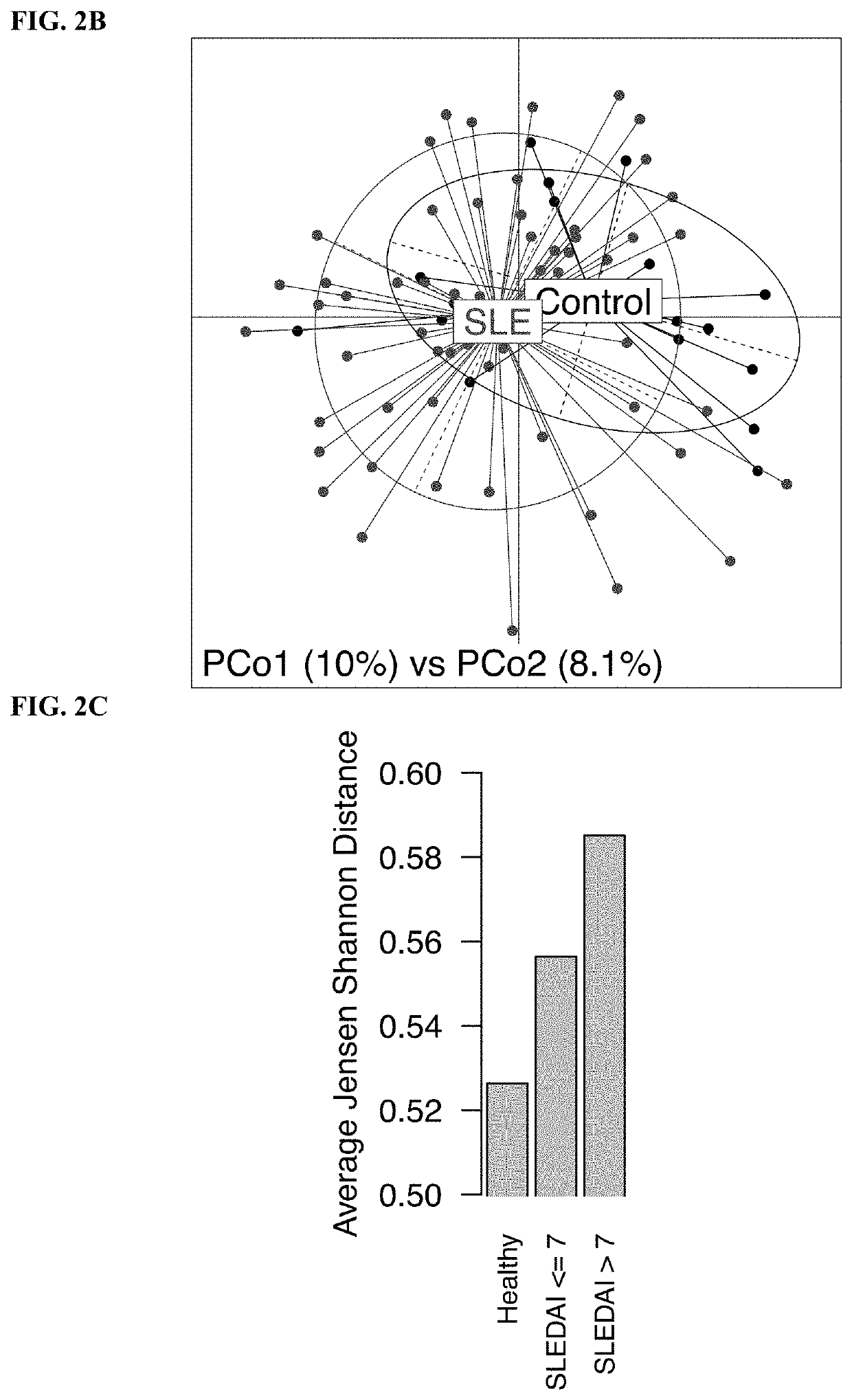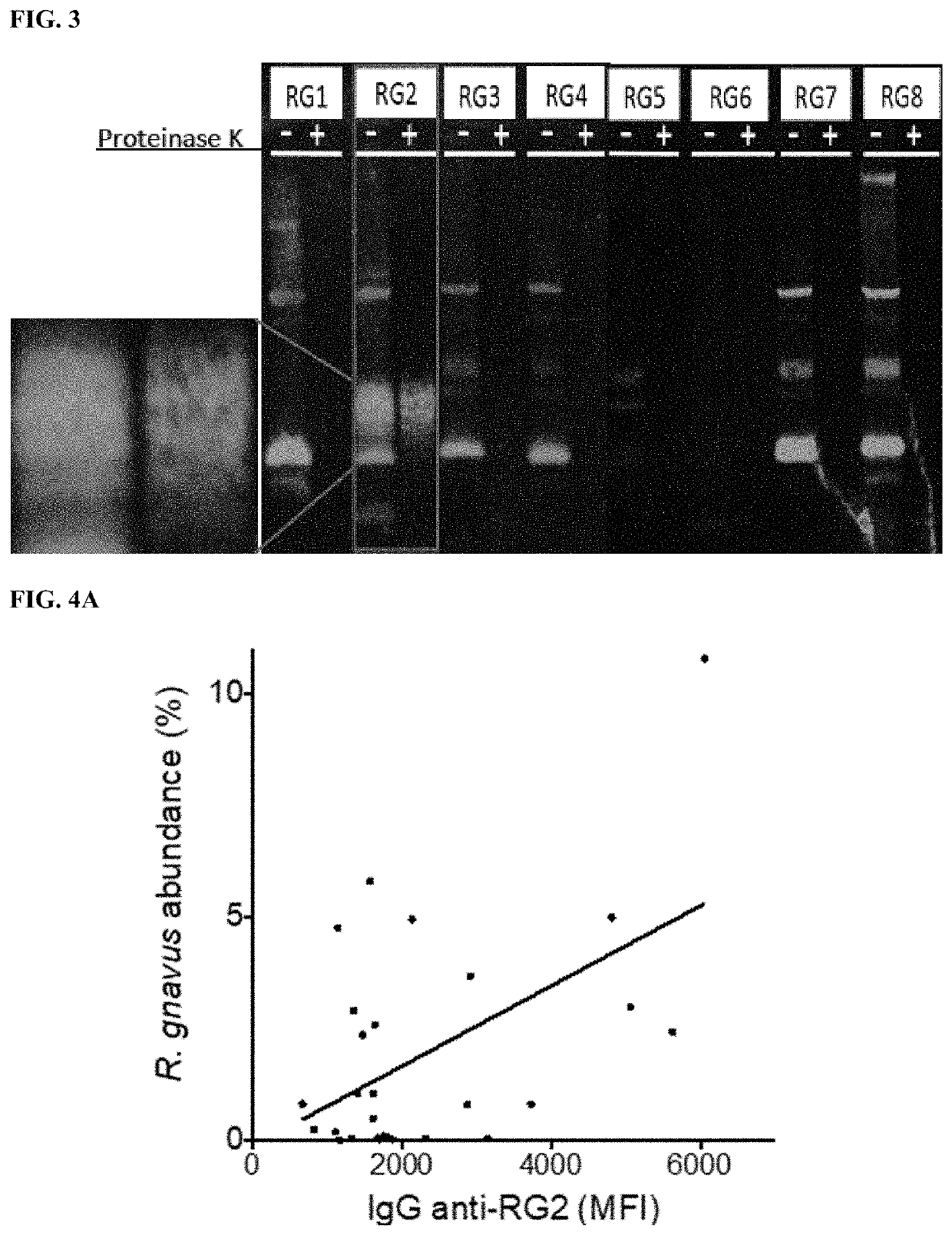Methods and compositions for treating and diagnosing autoimmune diseases
a technology for autoimmune diseases and compositions, applied in the field of autoimmune disease diagnosis, treatment and prevention, can solve the problems of wide spread of inflammation and tissue damage, insufficient treatment options for human lupus, and insufficient literature on the microbiome, etc., and achieve the effect of promoting a decrease in the level of antibodies
- Summary
- Abstract
- Description
- Claims
- Application Information
AI Technical Summary
Benefits of technology
Problems solved by technology
Method used
Image
Examples
example 1
icrobiome
[0367]A cross-sectional cohort of 130 adult multiethnic SLE patients, including three or more longitudinal samples from 6 patients, and 8 sample sets from patients at onset before start of medications, with SLEDAI from 0 to 19 was recruited. Six others were flaring off medications. From the 16S surveys of the fecal microbiome, it was surprisingly discovered that these SLE patients have recurrent patterns of dysbioses in their intestinal microbiomes (23, 24). Immunologic studies and fecal microbiome surveys of 61 Lupus patients and 18 healthy adult controls were completed. There were greater than 30 million assignable 16S reads for 243 samples. There was a clear difference in the microbiota of SLE patients in the richness of the fecal microbiomes (i.e., alpha diversity by Chao1 analysis) (FIG. 2A), compared to healthy controls, and significant differences in the composition of their microbiomes based on taxa (FIG. 2C).
[0368]The Hygiene Hypothesis postulates that the limited ...
example 3
icrobiome and Inflammatory Disease
[0384]To investigate the potential for taxa in SLE gut microbiomes to contribute to inflammatory disease, an SLE patient was selected with an SLEDAI of 15 with active renal disease, and high serum IgG anti-R. gnavus 2 antigen (BEI strain specific) antibodies at time of sampling. Fecal suspensions were thrice gavaged weekly into B6 groups. After 40 days, mice were sacrificed, and results show the SLE microbiome induced expansions of Th17 cells in LP and in the spleen, and expanded IFNγ producing T cells (FIG. 12). These findings suggest active SLE patients have gut taxa with properties akin to SFB that can cause murine autoimmune disease (51-54).
example 4
Test
[0385]This example provides a multiplex assay that can help to identify patients with different probable diagnoses, such as inflammatory bowel disease (IBD), IgA Nephropathy, and / or lupus nephritis.
[0386]Diagnoses were made by clinical criteria or based on renal biopsy, as appropriate. A Magpix (Lumina) system was used with different beads coated with the indicated antigen. Two bacterial strains of R. gnavus (CC55_001C, HM-1056 and VPI C7-9, 29149) were grown, and extracts treated as described above in the disclosure.
[0387]Patients with SLE often have IgG autoantibodies to DNA, nucleosomes, glomerular extracts, Sm and C1q. The frequency of each type of autoantibody is different in different patients. IgG anti-Sm antibodies may support a diagnosis of SLE, but are not believed to be related to renal disease. Some IgG anti-DNA antibodies may be more common in patients with Lupus nephritis (also called Lupus glomerulonephritis). Class IV refers to a World Health Organization histolo...
PUM
| Property | Measurement | Unit |
|---|---|---|
| Temperature | aaaaa | aaaaa |
| Fraction | aaaaa | aaaaa |
| Fraction | aaaaa | aaaaa |
Abstract
Description
Claims
Application Information
 Login to View More
Login to View More - R&D
- Intellectual Property
- Life Sciences
- Materials
- Tech Scout
- Unparalleled Data Quality
- Higher Quality Content
- 60% Fewer Hallucinations
Browse by: Latest US Patents, China's latest patents, Technical Efficacy Thesaurus, Application Domain, Technology Topic, Popular Technical Reports.
© 2025 PatSnap. All rights reserved.Legal|Privacy policy|Modern Slavery Act Transparency Statement|Sitemap|About US| Contact US: help@patsnap.com



